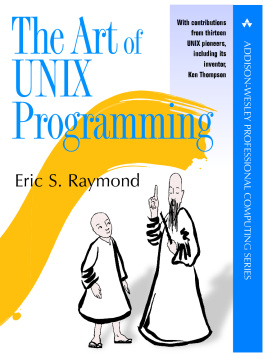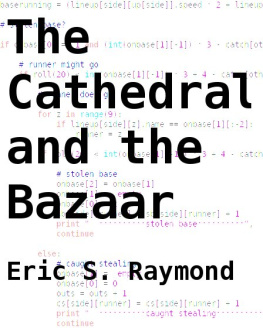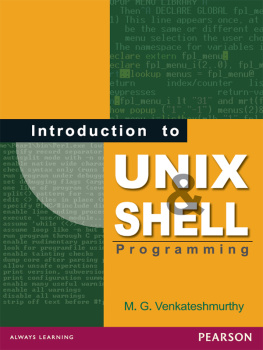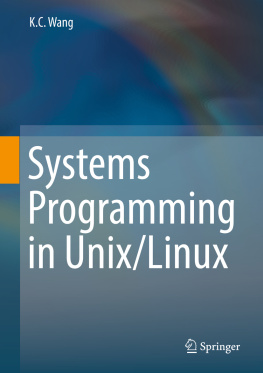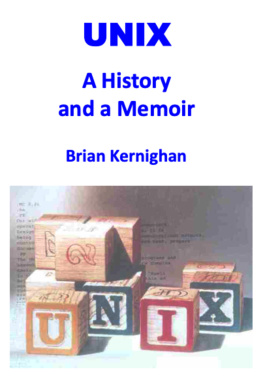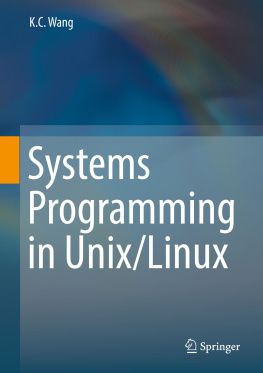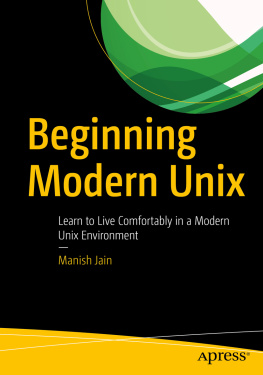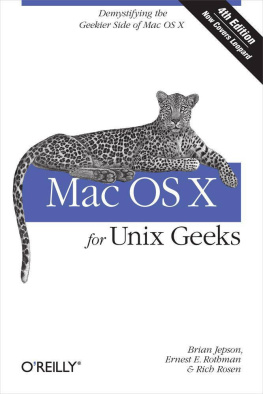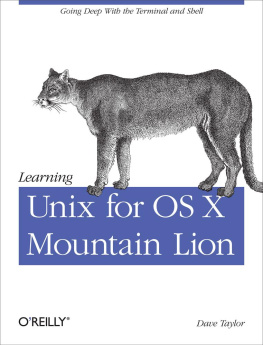The Art of Unix Programming
Copyright 2003 Eric S. Raymond
This book and its on-line version are distributed under the terms of the Creative Commons Attribution-NoDerivs 1.0 license, with the additional proviso that the right to publish it on paper for sale or other for-profit use is reserved to Pearson Education, Inc. A reference copy of this license may be found at http://creativecommons.org/licenses/by-nd/1.0/legalcode.
AIX, AS/400, DB/2, OS/2, System/360, MVS, VM/CMS, and IBM PC are trademarks of IBM. Alpha, DEC, VAX, HP-UX, PDP, TOPS-10, TOPS-20, VMS, and VT-100 are trademarks of Compaq. Amiga and AmigaOS are trademarks of Amiga, Inc. Apple, Macintosh, MacOS, Newton, OpenDoc, and OpenStep are trademarks of Apple Computers, Inc. ClearCase is a trademark of Rational Software, Inc. Ethernet is a trademark of 3COM, Inc. Excel, MS-DOS, Microsoft Windows and PowerPoint are trademarks of Microsoft, Inc. Java. J2EE, JavaScript, NeWS, and Solaris are trademarks of Sun Microsystems. SPARC is a trademark of SPARC international. Informix is a trademark of Informix software. Itanium is a trademark of Intel. Linux is a trademark of Linus Torvalds. Netscape is a trademark of AOL. PDF and PostScript are trademarks of Adobe, Inc. UNIX is a trademark of The Open Group.
The photograph of Ken and Dennis in appears courtesy of Bell Labs/Lucent Technologies.
The epigraph on the Portability chapter is from the Bell System Technical Journal, v57 #6 part 2 (July-Aug. 1978) pp. 2021-2048 and is reproduced with the permission of Bell Labs/Lucent Technologies.
| Revision History |
|---|
| Revision 1.0 | 19 September 2003 | esr |
| This is the content that went to Addison-Wesley's printers. |
| Revision 0.4 | 5 February 2003 | esr |
| Release for public review. |
| Revision 0.3 | 22 January 2003 | esr |
| First eighteen-chapter draft. Manuscript walkthrough at Chapter 12. Limited release for early reviewers. |
| Revision 0.2 | 2 January 2003 | esr |
| First manuscript walkthrough at Chapter 7. Released to Dmitry Kirsanov at AW production. |
| Revision 0.1 | 16 November 2002 | esr |
| First DocBook draft, fifteen chapters. Languages rewritten to incorporate lots of feedback. Transparency, Modularity, Multiprogramming, Configuration, Interfaces, Documentation, and Open Source chapters released. Shipped to Mark Taub at AW. |
| Revision 0.0 | 1999 | esr |
| Public HTML draft, first four chapters only. |
Preface
Table of Contents
Unix is not so much an operating system as an oral history.
-- Neal StephensonThere is a vast difference between knowledge and expertise. Knowledge lets you deduce the right thing to do; expertise makes the right thing a reflex, hardly requiring conscious thought at all.
This book has a lot of knowledge in it, but it is mainly about expertise. It is going to try to teach you the things about Unix development that Unix experts know, but aren't aware that they know. It is therefore less about technicalia and more about shared culture than most Unix books both explicit and implicit culture, both conscious and unconscious traditions. It is not a how-to book, it is a why-to book.
The why-to has great practical importance, because far too much software is poorly designed. Much of it suffers from bloat, is exceedingly hard to maintain, and is too difficult to port to new platforms or extend in ways the original programmers didn't anticipate. These problems are symptoms of bad design. We hope that readers of this book will learn something of what Unix has to teach about good design.
This book is divided into four parts: Context, Design, Tools, and Community. The first part (Context) is philosophy and history, to help provide foundation and motivation for what follows. The second part (Design) unfolds the principles of the Unix philosophy into more specific advice about design and implementation. The third part (Tools) focuses on the software Unix provides for helping you solve problems. The fourth part (Community) is about the human-to-human transactions and agreements that make the Unix culture so effective at what it does.
Because this is a book about shared culture, I never planned to write it alone. You will notice that the text includes guest appearances by prominent Unix developers, the shapers of the Unix tradition. The book went through an extended public review process during which I invited these luminaries to comment on and argue with the text. Rather than submerging the results of that review process in the final version, these guests were encouraged to speak with their own voices, amplifying and developing and even disagreeing with the main line of the text.
In this book, when I use the editorial we it is not to pretend omniscience but to reflect the fact that it attempts to articulate the expertise of an entire community.
Because this book is aimed at transmitting culture, it includes much more in the way of history and folklore and asides than is normal for a technical book. Enjoy; these things, too, are part of your education as a Unix programmer. No single one of the historical details is vital, but the gestalt of them all is important. We think it makes a more interesting story this way. More importantly, understanding where Unix came from and how it got the way it is will help you develop an intuitive feel for the Unix style.
For the same reason, we refuse to write as if history is over. You will find an unusually large number of references to the time of writing in this book. We do not wish to pretend that current practice reflects some sort of timeless and perfectly logical outcome of preordained destiny. References to time of writing are meant as an alert to the reader two or three or five years hence that the associated statements of fact may have become dated and should be double-checked.
Other things this book is not is neither a C tutorial, nor a guide to the Unix commands and API. It is not a reference for sed or yacc or Perl or Python. It's not a network programming primer, nor an exhaustive guide to the mysteries of X. It's not a tour of Unix's internals and architecture, either. Other books cover these specifics better, and this book points you at them as appropriate.
Beyond all these technical specifics, the Unix culture has an unwritten engineering tradition that has developed over literally millions of man-years[] of skilled effort. This book is written in the belief that understanding that tradition, and adding its design patterns to your toolkit, will help you become a better programmer and designer.
Cultures consist of people, and the traditional way to learn Unix culture is from other people and through the folklore, by osmosis. This book is not a substitute for person-to-person acculturation, but it can help accelerate the process by allowing you to tap the experience of others.

